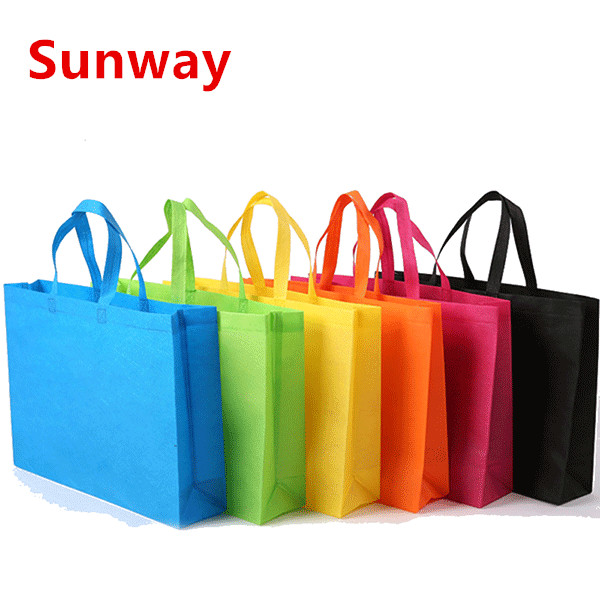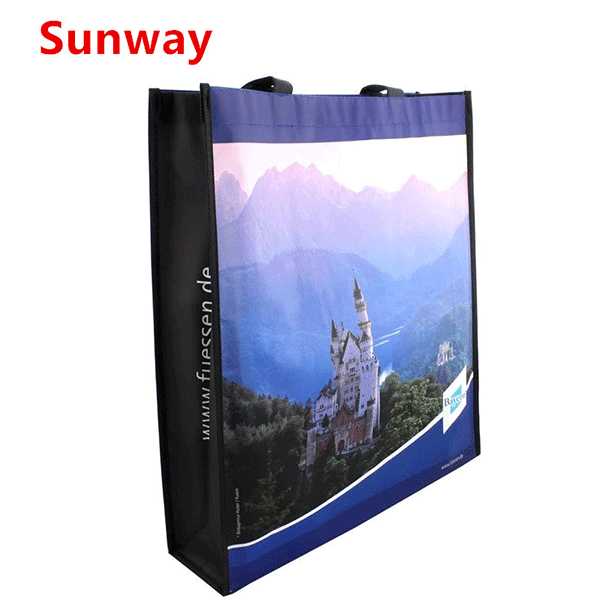Dear friend , if you are looking for non woven bags , just come here , as a professional manufacturer of packaging material , our non woven bags have many excellent functions as fellow:
1. With
economy
Plastic bags have been slowly disappearing from the packaging
market since the plastic restrictions were announced, replacing reusable
non-woven bags.
Non-woven bags are easier to print than plastic bags and have more vivid colors. In addition,
it can be used again and again. It can be considered to add more exquisite
patterns and advertisements on non-woven bags than plastic bags, because the
repeated use rate of non-woven bags is lower than that of plastic bags,
resulting in more cost saving and more obvious advertising benefits.
2.With strong enough
Traditional plastic bags are thin and easy to damage in order to
save cost.
But in order to make him stronger, it will have to be more costly. The
appearance of non - woven bag solves all problems, non - woven bag, strong
toughness, not easy to wear. In addition, a lot of mulch non-woven bags, in
addition to the strong, but also have waterproof, good texture, beautiful
appearance of the advantages. Although the cost per bag is a bit higher than
that of plastic bags, it can be used for hundreds, even thousands, of plastic
bags for a period of time.
3. Advertising in
accordance with
A practical and beautiful non-woven bag is not only a commodity
packaging bag.
Its exquisite appearance is even more impressive. It is a simple and
fashionable shoulder bag. With its strong, waterproof and non-stick
features, it will become the first choice for customers to go out. On such a
non-woven bag, you can print your company's logo or advertisement. The
advertising effect is self-evident.
4. With environmental protection
The ban was issued to address environmental issues. The reuse of
non-woven bags greatly reduces the pressure of garbage transformation. And now
advocate everybody environmental protection, can reflect the image of the
enterprise more. The resulting potential value is beyond money.
Basic Features:
1. Comparison with Traditional Labels There are three main forms of traditional label packaging: heat shrink label packaging and direct screen printing label packaging and adhesive label packaging (mainly self-adhesive label packaging). The direct screen printing label packaging method is to print the pattern and text on the container packaging by screen printing, the overall effect is good, the pattern and text have texture, but the quality of direct screen printing is not very ideal, more difficult to reflect Fine patterns and small text, at the same time if the color is more, the price of direct screen printing is more expensive; the use of heat shrink film (mainly PVC film) as the label packaging, as opposed to self-adhesive labels and direct screen printing labels The cost is low, but the heat-shrinkable label is easily damaged, the overall image is not very good, and it is not conducive to environmental protection; adhesive labels (mainly self-adhesive labels) can perfectly reflect the requirements of exquisite labels, but its cost is relatively hot Shrink film labels are more expensive. The emergence of in-mold labels harmonizes the advantages and disadvantages of the above three traditional main label packaging methods to a certain extent. In-mold labels can not only achieve the printing quality of self-adhesive labels, but also have the overall effect of direct screen printing. .
â—† From the point of view of the cost of the label, it is generally believed that if the color of the label is more than four colors, the cost is the most expensive of the three conventional label packaging methods. From the point of view of the cost of the label material, the in-mold label of the same type of surface material is compared with the self-adhesive label, and the label material in the mold does not require the backing paper, so the cost of the label material has a certain space for decline. At the same time, if in-mold labels are used, it is no longer necessary to add labeling equipment or labelling workers like heat-shrinkable labels and adhesive labels (adhesive labels), which can save the cost. However, due to the need for special die-cutting equipment in the process of in-mold label printing, and the complicated printing process, the cost of printing the in-mold labels may be higher than that of conventional labels.
â—† From an aesthetic point of view, first, in-mold labeling is a new form of packaging. The use of in-mold labeling is undoubtedly very novel, especially for daily chemical products with label as the main external packaging; secondly, in-mold labels are the same. The tight combination of the bottle body has the overall effect of direct screen printing, and can perfectly reflect the delicate patterns and fine texts like a sticker; again, the in-mold label is combined with the bottle body and is not dry. Plastic labels and heat-shrink labels are less likely to be damaged, fall off, etc., and can maintain the integrity and appearance of the labels for a longer period of time.
â—† Anti-counterfeiting perspective: Enhancing the product's anti-counterfeiting capability is now a major starting point for many manufacturers to use in-mold labels. Using in-mold labels has greatly improved the difficulty of counterfeiting: In-mold label printing and printing processes are more difficult than traditional labels. In addition, there are not many manufacturers that can provide in-mold labeling.
â—† From the perspective of environmental protection, common plastic containers are the same as YUPO's in-mold label materials, and since the labels are combined with the containers, the bottle recycling rate is higher and more convenient.
2. Some Limitations of In-Mold Labels Containers made using blow molding processes If you need to use in-mold labels, you must consider the curvature of the container. If the curvature of the container is too large, such as bumps, during the in-mold labeling process, there is difficulty in venting, and in-mold labels should not be used. Moreover, since the production cost of a blow molding machine for in-mold labeling is higher than that of a conventional blow molding machine, the user should use an in-mold label on a mature product having a considerable scale, and the bottle body curvature of the product must be small. Such a product has good stability and a large quantity. If an in-mold label is used, it can fully reflect the other advantages of the in-mold label while saving a great deal of cost. Applications and market outlook The range of applications for in-mold labels is very broad and can be applied to a variety of plastic containers, whether it be blow molding, injection molding or even stamping. In Europe and the United States, the proportion of in-mold labels in containers is about 12% to 15%, which is mainly used for daily-use products, lubricant products, foods, especially ice cream and other refrigerated foods, among which are The use of liquid detergents in the industry is more common.
The domestic in-mold label printing market is still an initial stage. Some well-known multinational corporations have been using in-mold labels on their foreign products for some time. However, there are few manufacturers and equipment that have high-quality in-mold labeling equipment in the past. The labeling process is not very mature, so the in-mold label printing processing market has been in the country for a while. After introducing YUPO in-mold label into the country, Xinyi Company has been working with related printing manufacturers, blow molding/injection manufacturers, and in-mold label blow molding/injection molding equipment suppliers. With the drastic reduction in the cost of blow molding machines and the increase in the printing process by the printing manufacturers, the in-mold labeling process has seen great development in China Packaging Information Network in the past year or two. 

Non Woven Bag,Non Woven Shopping Bags,Laminated Non Woven Bag,Custom Non Woven Bags
Shenzhen Sunway Packaging Material Co., Ltd , https://www.sunwaypack.com